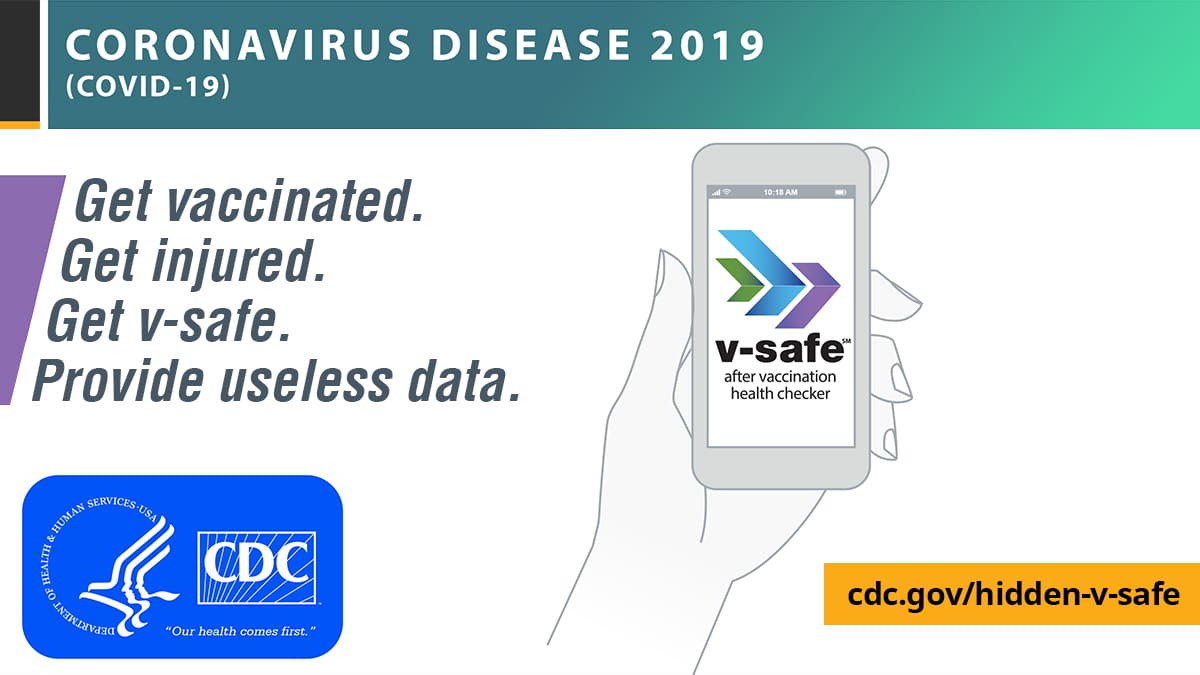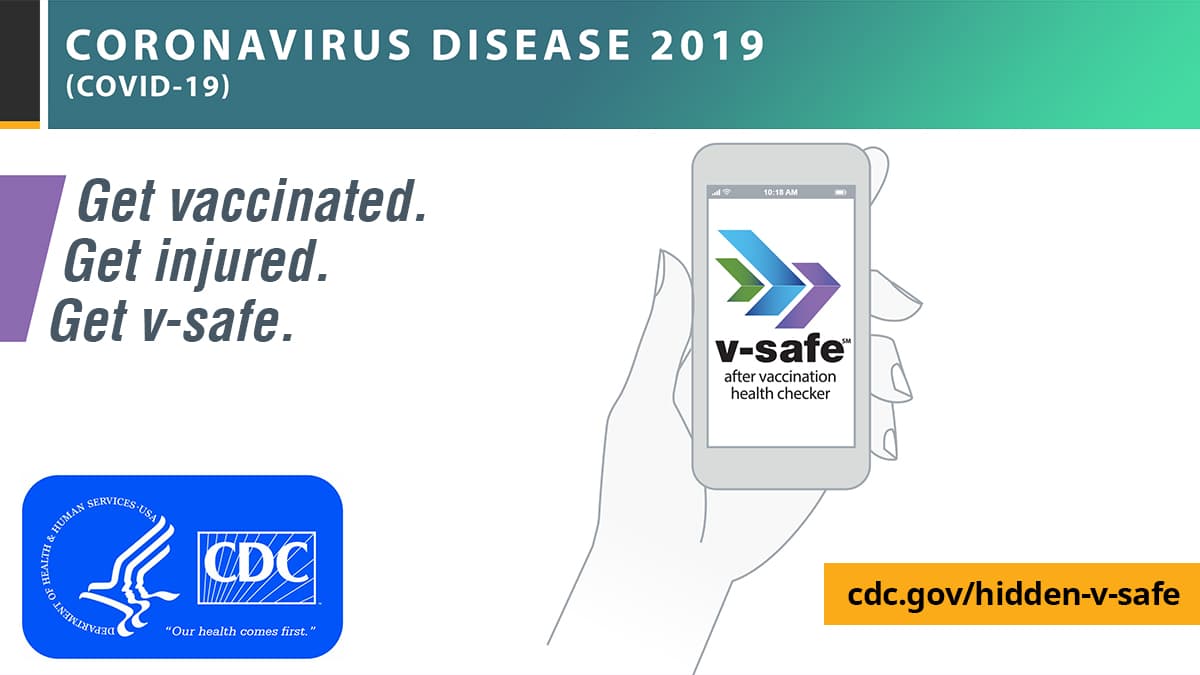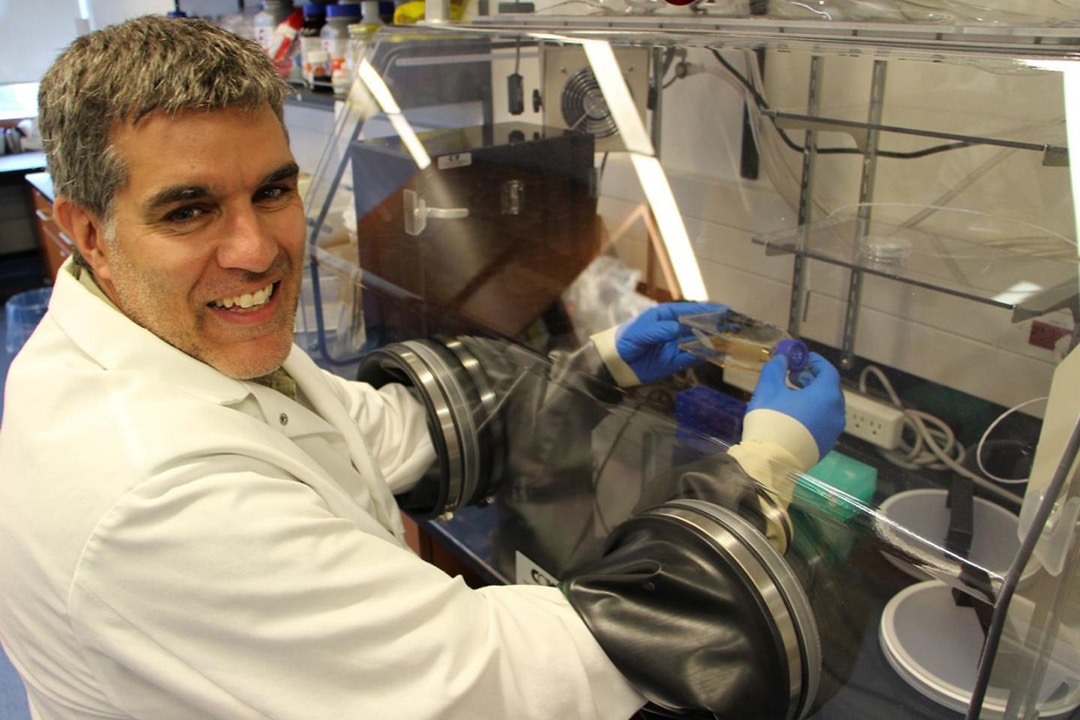
V-Safe Part 2: What Is V-Safe? What Data Does It Contain? Did It Ask About the Known Serious Potential Harms? And Why You Should Care!
by Aaron Siri | Nov 25, 2022
What is v-safe?
V-safe is a smartphone-based program rolled out by the CDC alongside the first authorized Covid-19 vaccine in December 2020. Both FDA and CDC love to make claims based on v-safe, including that “Covid-19 vaccines are monitored by the most intense safety monitoring efforts in US history.” V-safe was designed and released specifically to track health impacts following Covid vaccination by asking users to complete health check-ins.
As the CDC puts it:

After an individual has registered for v-safe, he or she is asked to complete a health “check-in” the day they receive a Covid vaccine. These “check-ins” prompt users to answer questions about their health, most of which contain pre-populated answers to choose from. The program also includes a handful of free-text fields where users can provide a limited amount of “other” information without being limited by check-the-box responses.
Users are prompted to submit a “check-in” every day for a week after a shot. Users are then prompted to submit a “check-in” every week for six weeks. And then at six months and one year after the shot. This is the same process following every dose or booster. A user cannot submit data retroactively.
Here are screenshots of what a daily check-in would look like for the first seven days after vaccination (days 0-7):
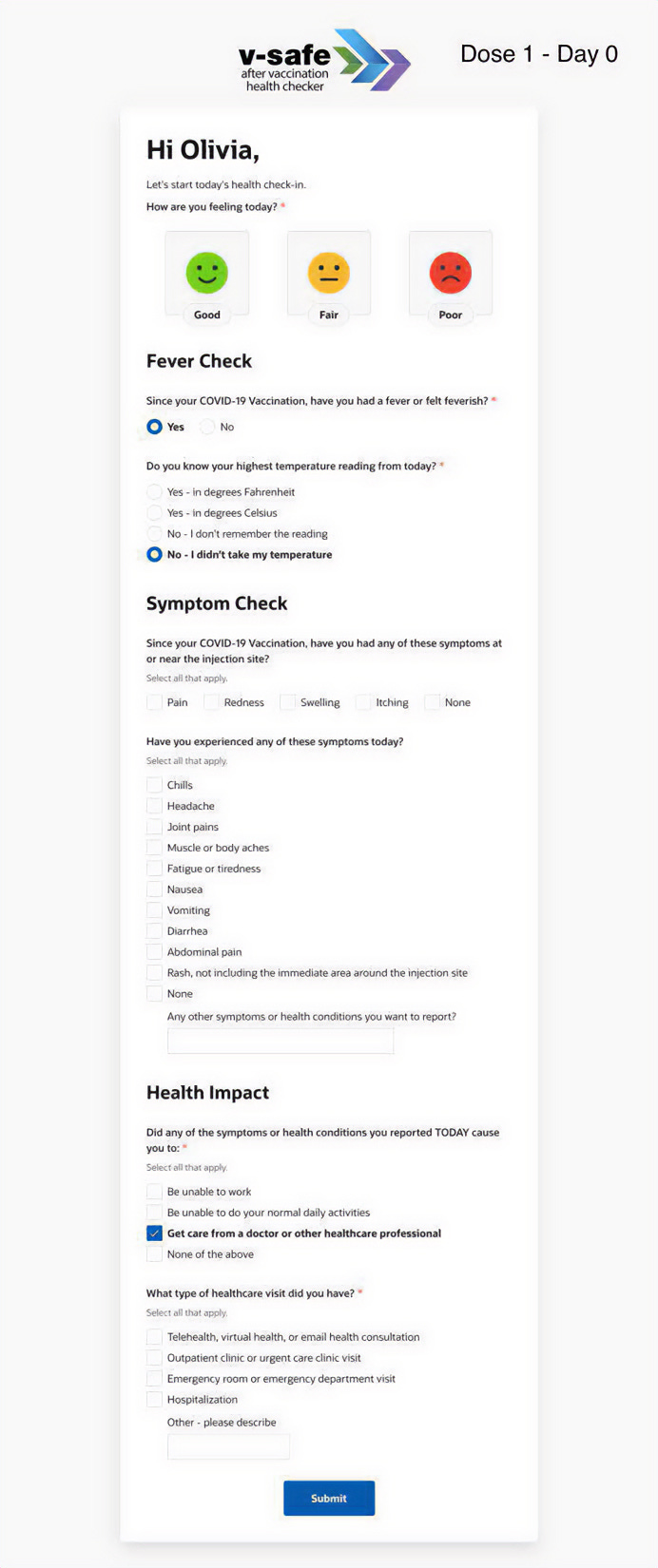
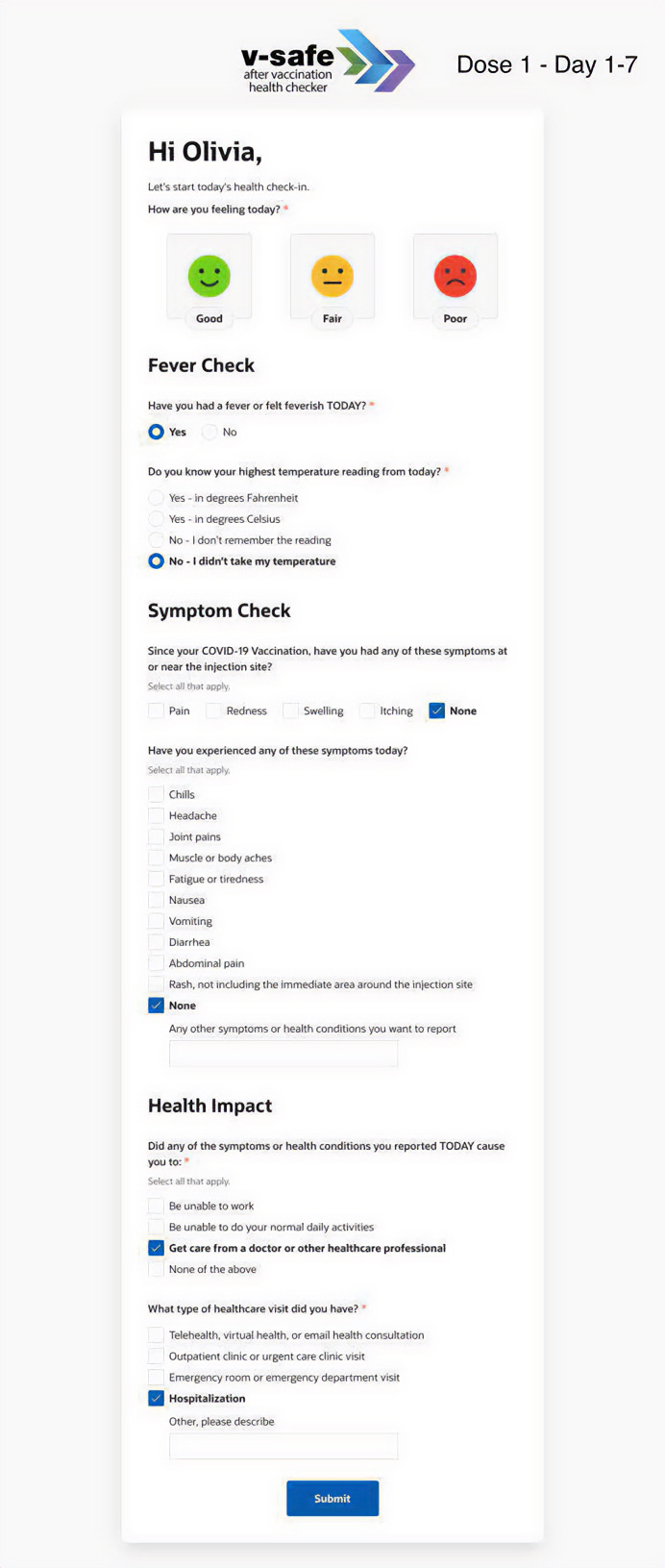
The above reflects the information that is collected in the first seven days post-vaccination. Then, once a week for the next six weeks, users are prompted to complete check-ins like the following:
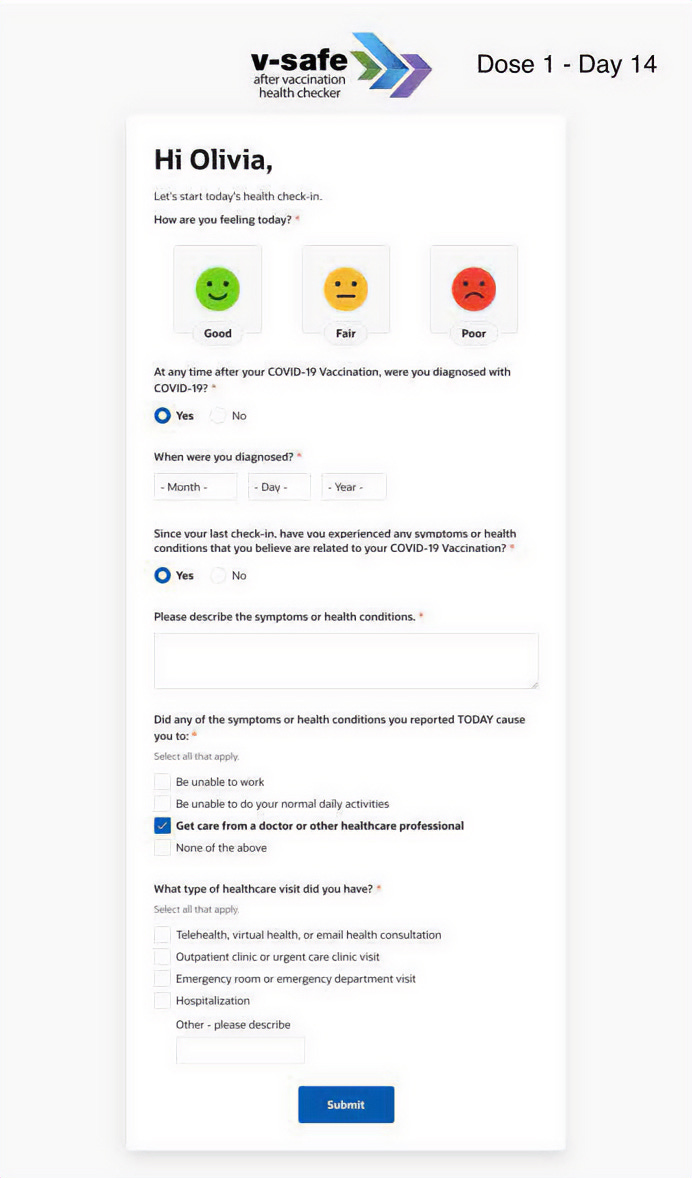
As you can see, v-safe only collected certain limited, pre-selected information in a systematic fashion. For the first seven days after a shot, it asked users to check one or more of the following symptoms:
- chills
- headache
- joint pain
- muscle or body aches
- fatigue or tiredness
- nausea
- vomiting
- diarrhea
- abdominal pain
- rash
During these first seven days, and then once a week for six weeks, and then at six months and one year, it asked users to pick, if applicable, one or more of the following three “health impacts:”
- unable to perform normally daily activities
- missed work/school
- needed medical care
Finally, if a user selected that he or she needed medical care, v-safe would ask the user to select one or more of these options:
- hospitalization
- emergency room
- urgent care
- telehealth
That is most of the safety information, other than the free text fields, that v-safe collected.
Precisely what v-safe data did the CDC produce?
So, precisely what v-safe health data did the CDC produce to ICAN? The data produced to date consists of responses to the check-the-box fields in the screenshots above. It is worth reviewing the relevant screenshots again so you can see the health information that was gathered and provided to ICAN, keeping in mind that only the responses to the check-the box questions (not the free-text questions) have been provided thus far. It is important to understand what was (and what was not) captured by v-safe as we continue to break down the v-safe saga.
You may also enjoy watching the CDC’s 30 second promotional video about v-safe:
How did the CDC decide to ask for only the above information?
A simple review of the information requested in the health check-ins may leave you wondering why some obvious symptoms and adverse events you would expect v-safe to collect are not being collected – like chest pain or any other cardiac symptoms. You may ask how the CDC determined what to ask v-safe users. And that is a great question. First, let’s remind ourselves what was known about potential adverse events before any Covid-19 vaccine was administered to the general public:
- A July 2020 New England Journal of Medicine study titled “An mRNA Vaccine against SARS-Cov-2 – Preliminary Report” highlighted 35 adverse events that were related to the mRNA vaccination, including eye disorders, gastrointestinal disorders, musculoskeletal and connective tissue disorders, and nervous system disorders.
- An October 16, 2020 JAMA article titled “Postapproval Vaccine Safety Surveillance for COVID-19 Vaccines in the US” stated that “AESIs [Adverse Events of Special Interest] are likely to include allergic, inflammatory, and immune-mediated reactions, such as anaphylaxis, Guillain-Barré syndrome, transverse myelitis, myocarditis/pericarditis, vaccine-associated enhanced respiratory disease, and multisystem inflammatory syndrome in children.”
- In a CDC presentation dated October 30, 2020, titled “CDC post-authorization/post-licensure safety monitoring of COVID-19 vaccines,” a preliminary “list of VSD pre-specified outcomes for RCA [rapid cycle analysis]” and “list of VAERS AEs[ adverse events] of special interest” both included acute myocardial infarction, anaphylaxis, convulsions/seizures, encephalitis, Guillain-Barre syndrome, immune thrombocytopenia, MIS-C, myocarditis/pericarditis, and transverse myelitis, among others.
Again, the fact that mRNA can cause these serious conditions was raised before the first Covid-19 vaccine was authorized for use by the general public in December 2020 – in fact, months before. d
Reflecting the concern that mRNA vaccines can cause these serious conditions, the CDC’s own protocol for v-safe, at least as early as January 28, 2021 (we are, on behalf of ICAN, working to get earlier versions), identified “Adverse Events of Special Interest” which it placed in a chart entitled “Prespecified Medial Conditions.” This included 15 serious conditions of special interest to track after Covid vaccination. Here is the relevant excerpt from the CDC’s v-safe protocol:
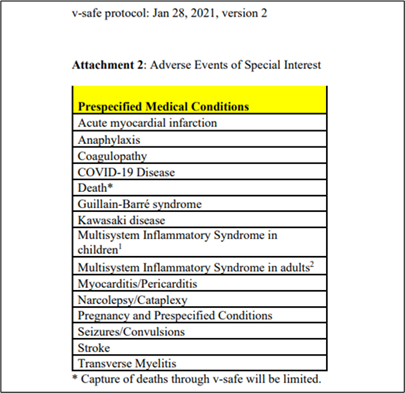
Again, this list was from the CDC’s own protocol used to develop v-safe. And, as seen above, this list included, among other serious concerns, myocarditis, pericarditis, acute myocardial infarction, stroke, GBS, and transverse myelitis. Yet v-safe was launched without including any check-the-box fields for these conditions and v-safe was never subsequently updated to include any check-the-box fields for these conditions.
Evidence of Premeditation
It is often difficult to obtain evidence showing premeditated wrongful conduct. In this instance, the choice by the folks at the CDC to not include these adverse events of special interest, which studies prior to the launch of v-safe had already reflected could be caused by mRNA vaccine, and which the CDC itself identified in its v-safe protocol, may be one of the best and most compelling pieces of evidence supporting premediated conduct by the CDC.
The CDC could have taken advantage of this incredible opportunity – wherein v-safe was already capturing health data from over 10 million users – and easily included these conditions as check-the-box options for v-safe users. Then it would be easy to calculate a rate for which v-safe users had myocarditis. Had a stroke. Had seizures. Etc. Instead, the CDC purposely chose to limit reporting of any such adverse events to the free text fields knowing full well that, among other issues, users often do not fill out free-text fields, that any entries received would not be easily standardized, and that the CDC could otherwise more easily hide those entries from the public (as the CDC is currently doing by refusing to make the free-text field data public).
Reflecting that the CDC knew these serious adverse events were critical to track, and that the CDC sought to obfuscate reports of these harms, the CDC created an incredibly complex system to deal with text field reports of these conditions. If a v-safe user reported one of these conditions, someone at the CDC would have to agree that what was written in a free text field actually reflected one of these conditions, then someone from the CDC was supposed to reach out to the v-safe user by telephone (which, as discussed in a future part, often did not occur or occurred months or years later), and if the CDC ever actually reached out and thought the condition described was on the list, then the CDC employee could assist the user in completing a VAERS report. And then, once in VAERS, the CDC, as it does, would say that VAERS reports (i) cannot ever be used to show a vaccine causes a harm and (ii) cannot be used to determine a rate at which it may cause a harm because VAERS receives reports from an unknown population size. Meaning, the CDC says it doesn’t know the denominator needed to calculate a rate using VAERS data.
But had the CDC simply had a check-the-box field in v-safe for each of these conditions, it would have had a denominator. It could simply divide the number of v-safe users reporting the condition by the total number of v-safe users. And boom, there it would be! The rate. Instead, the CDC knowingly, consciously, chose to not create check-the-box options for these serious adverse events, even though it had itself identified them as safety issues to track prior to the launch of v-safe.
And what check-the-box options did the CDC include in v-safe? For the first week, a list of conditions (such as arm pain, fever, fatigue, etc.) the CDC does not label as adverse events, but rather as reactogenicity (which the CDC couches as a good thing because it shows, according to the CDC, that the vaccine is working). Meaning, the first week reactogenicity data collected by v-safe is effectively useless for assessing any actual safety concerns.
The only other significant safety data v-safe collected was the “health impact” data of whether someone could not perform normal daily activities, missed school/work, or needed medical care. As discussed above, it collected this data during the first week but also weekly thereafter for 6 weeks, and then once at 6 months and finally at one year.
Presumably, the CDC determined that collecting this health impact data would provide enough information to determine whether the vaccine is “safe.” It is, after all, called “v-safe.” And this is effectively the only actual potentially useful systematic data it collected in v-safe! So, presumably when 7.7% of users reported needing medical care, and an additional 25% reported being unable to perform normal activities and/or missed school or work, that would have raised alarm bells. But I am jumping at few parts ahead – more on that later.
In part 3, we will take a look at who registered for v-safe: Was it those concerned about vaccines? Those supportive of vaccines? We will take a close look.


